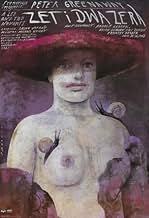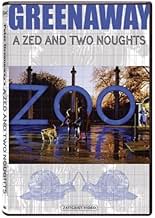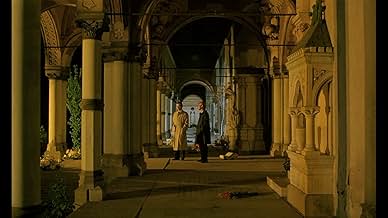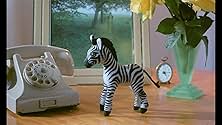Ajouter une intrigue dans votre langueTwin zoologists lose their wives in a car accident and become obsessed with decomposing animals.Twin zoologists lose their wives in a car accident and become obsessed with decomposing animals.Twin zoologists lose their wives in a car accident and become obsessed with decomposing animals.
- Director
- Writers
- Stars
Avis en vedette
For better or for worse, A Zed & Two Noughts is a very unusual film. This is hardly surprising given that it was directed by the avant-gardist director Peter Greenaway. It begins with a car accident at a zoo, where two women are killed when their vehicle collides with a pregnant swan. These women are twins who were in turn married to a couple of twin zoologists, Oliver and Oswald Deuce. Shortly afterwards these men start simultaneous affairs with the survivor of the accident, the driver Alba Bewick who lost a leg as a result of the crash. She later has the other one removed surgically for symmetrical reasons and falls pregnant to the twins.
This strange film features both the good and the bad typical of Greenaway. The good is the visual presentation and distinctive bizarre qualities, the bad is more or less any time someone opens their mouths, which unfortunately is quite often. Greenaway is really terrible at writing dialogue. His script constantly tries to be clever, which is not the same thing as actually being clever. Needless to say, the dialogue is painful to listen to and ultimately makes the film hard work and not in a good way. But setting this aside, amongst other things, it's an intriguing concoction about symmetry, birth and decay. Of the latter are several time-lapse films showing a variety of animals and organic matter decaying - films which were fascinating and repulsive in equal measure. We also have excellent cinematography from Greenaway's common collaborator Sacha Vierney, with many shots being a joy to behold. The other significant cog in the wheel is the typically persistent minimalist score from Michael Nyman, which is sometimes brilliant even if it does border on irritating at others. We also have the most unexpected collaborator in any Greenaway film - none other than Jim 'Nick Nick' Davidson, the politically incorrect stand-up comedian who appears as a zoo-keeper.
In summary, A Zed & Two Noughts was an interesting film spoiled by Greenaway's horrible dialogue and awful characters. If you can get beyond those it does offer some fascinating stuff but you sure have got your work cut out with this one.
This strange film features both the good and the bad typical of Greenaway. The good is the visual presentation and distinctive bizarre qualities, the bad is more or less any time someone opens their mouths, which unfortunately is quite often. Greenaway is really terrible at writing dialogue. His script constantly tries to be clever, which is not the same thing as actually being clever. Needless to say, the dialogue is painful to listen to and ultimately makes the film hard work and not in a good way. But setting this aside, amongst other things, it's an intriguing concoction about symmetry, birth and decay. Of the latter are several time-lapse films showing a variety of animals and organic matter decaying - films which were fascinating and repulsive in equal measure. We also have excellent cinematography from Greenaway's common collaborator Sacha Vierney, with many shots being a joy to behold. The other significant cog in the wheel is the typically persistent minimalist score from Michael Nyman, which is sometimes brilliant even if it does border on irritating at others. We also have the most unexpected collaborator in any Greenaway film - none other than Jim 'Nick Nick' Davidson, the politically incorrect stand-up comedian who appears as a zoo-keeper.
In summary, A Zed & Two Noughts was an interesting film spoiled by Greenaway's horrible dialogue and awful characters. If you can get beyond those it does offer some fascinating stuff but you sure have got your work cut out with this one.
Greenaway's obsessions with lists, wordplay, coincidence, sexuality, the surreal, and the explicit (not to mention the "conventionally used" ones like men and women, birth and eating and death, physiology (formal and psychological), and abstraction) come to a head in this film. A bizarre mileau of fancy digressions and focused narrativity create a film which is perhaps too obtuse for first time viewers but is, as far as I'm concerned, the best way to initiate oneself into the "world" of Greenaway.
(Movie quote) - "So, tell me - Is a zebra a white animal with black stripes, or is it a black animal with white stripes?"
Even though I definitely found this 1985, British, "art" film to be something of a "hit'n'miss" production, it was its very striking camera-work by French cinematographer, Sacha Vierny, that certainly helped to elevate it to a position that set it well-beyond the realm of being considered just purely mundane entertainment.
Surreal, eccentric and bizarre (and, yes, at times, quite puzzling) - "A Zed And 2 Noughts" definitely had me wondering, often enough, what kind of a curve director Peter Greenaway was going to hurl at me next with this weird and somewhat disturbing tale of obsession with decaying flesh and the amputation of body parts.
Certainly not a film to please everyone (and certainly not a film with a gripping plot-line) - I, for one, thought "A Zed And 2 Noughts" was well-worth a view simply for the freakish biology lesson that it quite cleverly wedged into its wacky, little story (all at no extra cost).
Even though I definitely found this 1985, British, "art" film to be something of a "hit'n'miss" production, it was its very striking camera-work by French cinematographer, Sacha Vierny, that certainly helped to elevate it to a position that set it well-beyond the realm of being considered just purely mundane entertainment.
Surreal, eccentric and bizarre (and, yes, at times, quite puzzling) - "A Zed And 2 Noughts" definitely had me wondering, often enough, what kind of a curve director Peter Greenaway was going to hurl at me next with this weird and somewhat disturbing tale of obsession with decaying flesh and the amputation of body parts.
Certainly not a film to please everyone (and certainly not a film with a gripping plot-line) - I, for one, thought "A Zed And 2 Noughts" was well-worth a view simply for the freakish biology lesson that it quite cleverly wedged into its wacky, little story (all at no extra cost).
All you need to make cinema is a point of view (and of course the view to which it points). Or a frame of reference and the reference which it frames. In Greenaway all these exist together, knowingly, as forms within forms.
A story of twins looking to overcome grief by studying the decay of death is the reference here. Zebras, lizards, swans, we see the empty shells of body decay before the camera. Kept under the scrutiny of our gaze in life, inside cages, they remain under it once dead. At what point do all these symmetries which conjoined together make up the miracle of life stop being the sum of their parts, and by which process; how much of these parts that we understand as the self can be taken out before the self is no longer recognized; and the symmetry once broken, what mystery renews it.
These obscure ruminations are framed against the question of existence, which implies god and pattern. How come that something so systemised, so perfectly designed and evolved from nothing, from amoeba and algea, can come to pass by the whim of chance? Having taken millions of years for creation to unravel its complexity, why does it take a second to destroy it? Which is to ask, at what point does the system, which in hindsight appears ordained and patterned, become random and meaningless.
Various eccentricities are enacted in this process, all pointing to some kind of symbolic nakedness.
When the legless woman gives birth to new life, twins again, the old twins, the blueprint for them, must step aside. The film ends with an poignant thought. Having carefully staged their own death so that the decay that follows may be captured on film, we see how nature intrudes upon this scene and foils the effort.
An atheist himself, Greenaway here gives us a pessimism that cuts deep; no consciousness survives this.
A story of twins looking to overcome grief by studying the decay of death is the reference here. Zebras, lizards, swans, we see the empty shells of body decay before the camera. Kept under the scrutiny of our gaze in life, inside cages, they remain under it once dead. At what point do all these symmetries which conjoined together make up the miracle of life stop being the sum of their parts, and by which process; how much of these parts that we understand as the self can be taken out before the self is no longer recognized; and the symmetry once broken, what mystery renews it.
These obscure ruminations are framed against the question of existence, which implies god and pattern. How come that something so systemised, so perfectly designed and evolved from nothing, from amoeba and algea, can come to pass by the whim of chance? Having taken millions of years for creation to unravel its complexity, why does it take a second to destroy it? Which is to ask, at what point does the system, which in hindsight appears ordained and patterned, become random and meaningless.
Various eccentricities are enacted in this process, all pointing to some kind of symbolic nakedness.
When the legless woman gives birth to new life, twins again, the old twins, the blueprint for them, must step aside. The film ends with an poignant thought. Having carefully staged their own death so that the decay that follows may be captured on film, we see how nature intrudes upon this scene and foils the effort.
An atheist himself, Greenaway here gives us a pessimism that cuts deep; no consciousness survives this.
I knew how strange and unusual Greenaway could be but Zed, I believe could take the cake :). I am not sure what it is all about but I still enjoy the triumvirate Greenaway - Sasha Verny- Michael Nyman. Some ideas and images Greenaway will use in the later "8 1/2 women" and "The Cook, The Thief, His Wife, and Her Lover" - especially, the soundtrack. "Dead Ringers" and "Mon oncle d'Amérique" (two beautiful weirdnesses themselves) also come to mind while watching Greenaway's elegant tale of decomposing which is also his meditations about life, death and grief. As in earlier "The Draughtsman's Contract (1982), Greenaway explores the relationship between the close relatives - the twin brothers are in the center of "A Zed & two Noughts". The movie is also a modern retelling of an ancient myth about Leda and Zeus who took the form of a swan and slept with Leda on the same night as her husband, King Tyndareus. Leda bore Helen and Polydeuces, children of Zeus while at the same time bearing Castor and Clytemnestra, children of her husband Tyndareus, the King of Sparta.
Greenaway considers that 90% of his films one way or another refers to paintings. "A Zed & two Noughts" refers openly and with great admiration to the paintings of Johannes Vermeer van Delft.
"A Zed & two Noughts" is not easy film to watch, its characters are not sympathetic, it lacks warmth and sentimentality but as always in Greenaway's films, it is a feast for eyes, ears, and for brain.
7.5/10
Greenaway considers that 90% of his films one way or another refers to paintings. "A Zed & two Noughts" refers openly and with great admiration to the paintings of Johannes Vermeer van Delft.
"A Zed & two Noughts" is not easy film to watch, its characters are not sympathetic, it lacks warmth and sentimentality but as always in Greenaway's films, it is a feast for eyes, ears, and for brain.
7.5/10
Le saviez-vous
- AnecdotesThis film was Peter Greenaway's first collaboration with cinematographer Sacha Vierny, who went on to shoot virtually all of Greenaway's work in the 1980s and 1990s, until Vierny's death in 2001. Greenaway referred to Vierny as his "most important collaborator".
- Citations
Alba Bewick: In the land of the legless the one-legged woman is queen.
- ConnexionsFeatured in Peter Greenaway (1992)
- Bandes originalesThe Teddy Bears' Picnic
Music by John W. Bratton
Lyrics by Jimmy Kennedy
Performed by The BBC Dance Orchestra
Directed by Henry Hall
Courtesy of EMI MUSIC PUBLISHING LTD and EMI RECORDS LTD
Also sung by Venus De Milo (Frances Barber)
Meilleurs choix
Connectez-vous pour évaluer et surveiller les recommandations personnalisées
- How long is A Zed & Two Noughts?Propulsé par Alexa
Détails
- Date de sortie
- Pays d’origine
- Langues
- Aussi connu sous le nom de
- A Zed and Two Noughts
- Lieux de tournage
- sociétés de production
- Consultez plus de crédits d'entreprise sur IMDbPro
Contribuer à cette page
Suggérer une modification ou ajouter du contenu manquant

Lacune principale
By what name was A Zed & Two Noughts (1985) officially released in Canada in English?
Répondre




























